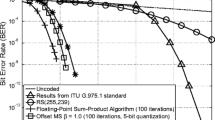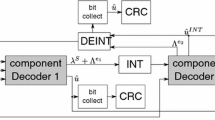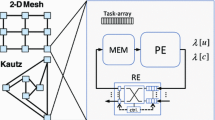Abstract
LDPC codes can be designed to perform extremely close to the Shannon limit. Achieving such performance with high energy efficiency is now a main goal in the research community. This work combines knowledge of LDPC decoder message statistics, provided by density evolution, with knowledge of the physical implementation of decoders to predict switching activity in the decoder interconnect. In this work we provide results for the switching activity on the interconnect for fully parallel decoders. However, our model can be applied to partially parallel and serial implementations, and is not limited to interconnect. It is shown that switching activity can vary by as much as 300%, depending on several hardware design choices. Results of this work validate the usefulness of the presented model for providing designers with an understanding of how their decoder implementation choices affect power consumption for any size of LDPC code. This knowledge can be used for making design choices that minimize decoder power consumption very early in the hardware design process.








Similar content being viewed by others
References
IEEE 802.3 CSMA-CD (Ethernet) (2008). http://ieee802.org/3/.
IEEE 802.11n/D1.0 (2006). Wireless LAN medium access control and physical layer specifications: Enhancements for higher throughput. http://www.ieee802.org/11/index.shtml.
IEEE 802.16e/D12 (2005). Air interface for fixed and mobile broadband wireless access systems. http://www.ieee802.org/16/index.html.
EN 302307 V1.1.1 (2008). Digital video broadcasting (DVB) second generation framing structure for broadband satellite applications. European Telecommunications Standards Institute (ETST). www.dvb.org.
Yeo, E., Nikolic, B., & Anantharam, V. (2002). Architectures and implementations of low-density parity check decoding algorithms. In Proceedings of the 45th midwest symposium on circuits and systems (MWSCAS) (Vol. 3, pp. III-437–III-440).
Mansour, M. M., & Shanbhag, N. R. (2002). Low-power VLSI decoder architectures for LDPC codes. In Proceedings of the international symposium on low power electronics and design (ISLPED) (pp. 284–289).
Darabiha, A., Chan Carusone, A., & Kschischang, F. R. (2008). Power reduction techniques for LDPC decoders. IEEE Journal of Solid-State Circuits, 43(8), 1835–1845.
Shih, X., Zhan, C., Lin, C., & Wu, A. (2008). An 8.29 mm2 52 mW multi-mode LDPC decoder design for mobile WiMAX system in 0.13μm CMOS process. IEEE Journal of Solid-State Circuits, 43(3), 672–683.
Zhang, Z., Anantharam, V., Wainwright, M. J., & Nikolic, B. (2009). A 47Gb/s LDPC decoder with improved low error rate performance. Symposium on VLSI circuits (pp. 286–287).
Gaudet, V. C., & Gross, W. J. (2006). On density evolution and dynamic power estimation in stochastic iterative decoders. In Proceedings of the fifth analog decoding workshop. Torino, Italy.
Gaudet, V. C., Schlegel, C., & Dodd, R. (2007). LDPC decoder message formatting based on activity factor minimization using differential density evolution. In Proceedings of the IEEE information theory workshop (ITW) (pp. 571–576).
Gaudet, V., & Gross, W. (2010). Switching activity in stochastic decoders. In IEEE international symposium on multiple-valued logic (pp. 167–172). Barcelona, Spain.
Tanner, R. (1981). A recursive approach to low complexity codes. IEEE Transactions on Information Theory, 27(5), 533–547.
Gallager, R. G. (1963). Low density parity check codes. M.I.T. Press.
Chung, S., Forney, G. D. Jr., Richardson, T. J., & Urbanke, R. (2001). On the design of low-density parity-check codes within 0.0045 dB of the Shannon limit. IEEE Communications Letters, 5(2), 58–60.
MacKay, D. (2003). Information theory, inference, and learning algorithms. Cambridge University Press.
Hemati, S., & Banihashemi, A. (2006). Dynamics and performance analysis of analog iterative decoding for low-density parity-check (LDPC) codes. IEEE Transactions on Communications, 54(1), 61–70.
Gross, W. J., Gaudet, V. C., & Milner, A. (2005). Stochastic implementation of LDPC decoders. In Conference record of the thirty-ninth asilomar conference on signals, systems and computers (pp. 713–717).
MacKay, D. J. C., & Neal, R. M. (1996). Near Shannon limit performance of low density parity check codes. Electronics Letters, 32(18), 1645.
Chung, S. Y., Richardson, T., & Urbanke, R. (2001). Analysis of sum-product decoding of low-density parity-check codes using a Gaussian approximation. IEEE Transactions on Information Theory, 47(2), 657–670.
Richardson, T. J., & Urbanke, R. L. (2001). The capacity of low-density parity-check codes under message-passing decoding. IEEE Transactions on Information Theory, 47(2), 599–618.
Schlegel, C., & Perez, L. (2004). Trellis and turbo coding. John Wiley and Sons.
Howland, C., & Blanksby, A. (2001). Parallel decoding architectures for low density parity check codes. In Proceedings of the IEEE international symposium on circuits and systems (Vol. 4, pp. 742–745).
Acknowledgement
This work was done while the authors were at the University of Alberta. The authors would like to thank Alberta iCORE for funding this research work.
Author information
Authors and Affiliations
Corresponding author
Rights and permissions
About this article
Cite this article
Crowley, B., Gaudet, V. Switching Activity Minimization in Iterative LDPC Decoders. J Sign Process Syst 68, 63–73 (2012). https://doi.org/10.1007/s11265-011-0577-y
Received:
Revised:
Accepted:
Published:
Issue Date:
DOI: https://doi.org/10.1007/s11265-011-0577-y




